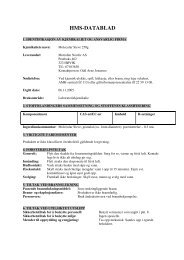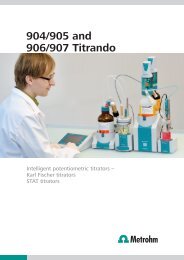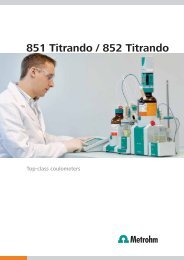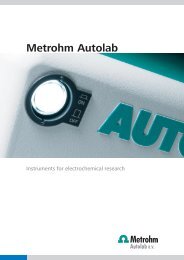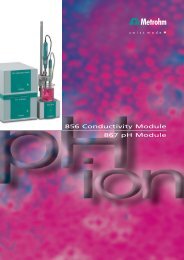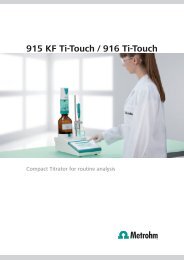General Catalog
General Catalog
General Catalog
Create successful ePaper yourself
Turn your PDF publications into a flip-book with our unique Google optimized e-Paper software.
Instruments for polarography, voltammetry and CVS<br />
CVS – Cyclic Voltammetric Stripping<br />
Determination of additives in electroplating<br />
baths<br />
Cyclic Voltammetric Stripping Analysis (CVS) and<br />
Cyclic Pulse Voltammetric Stripping Analysis (CPVS)<br />
are widespread methods used in the plating industry<br />
for the determination of organic additives in electroplating<br />
baths. A simply constructed, robust and favorably-priced<br />
rotating disk electrode made of platinum is<br />
used for these analyses; this electrode is built into the<br />
VA stand instead of the otherwise used Multi-Mode<br />
Electrode. For many technical coatings, particularly<br />
in PCB manufacture in the electronics industry, this<br />
method is an essential part of the production control<br />
process. The most important fields of application are<br />
acid copper baths as well as tin-lead baths. The quantitative<br />
determination of the additives is carried out by<br />
utilizing their influence on the deposition of the main<br />
components of the electroplating bath. As the measurement<br />
corresponds to a process which is similar to<br />
the production process, the activity of the additives<br />
and therefore their effectiveness in the electroplating<br />
process is measured directly.<br />
Quantification of the various types of additives<br />
requires special calibration techniques; these are all<br />
implemented in the new 797 VA Computrace: The<br />
so-called brighteners are determined by using the Linear<br />
Approximation Technique (LAT) or the Modified<br />
Linear Approximation Technique (MLAT). Dilution<br />
Titration (DT) is used for the determination of the suppressors.<br />
With CVS or CPVS the concentration of the additives<br />
can be determined exactly. The effective concentration<br />
of the particular additive in the bath sample is shown<br />
directly and printed out in mL additive per liter bath.<br />
This means that topping up to achieve the set concentration<br />
can be carried out very exactly. This guarantees<br />
continuous interference-free operation of the unit.<br />
Accuracy of analytical results in particular has helped<br />
this method to become widely accepted in the electroplating<br />
industry.<br />
Other methods, such as the classical Hull cell method,<br />
do not allow the concentration to be determined, but<br />
can only be used to assess the quality of the metallic<br />
layer which has been deposited.<br />
To carry out the determination one of the pre-installed<br />
methods is loaded. After a few parameters have been<br />
adapted, the analysis can be started. Ready-to-use<br />
methods are included for the most important types<br />
of bath from leading manufacturers; these have been<br />
worked out in our application laboratory.<br />
Rotating platinum electrode for the determination of additives in<br />
plating baths by CVS<br />
— VA




